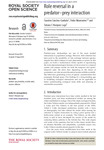| dc.contributor.author | Sánchez Garduño, Faustino | en_US |
| dc.contributor.author | Miramontes, Pedro | en_US |
| dc.contributor.author | Marquez-Lago, Tatiana T. | en_US |
| dc.date.accessioned | 2016-07-18T06:49:07Z | |
| dc.date.available | 2016-07-18T06:49:07Z | |
| dc.date.issued | 2014 | en_US |
| dc.identifier.other | HPU4160423 | en_US |
| dc.identifier.uri | https://lib.hpu.edu.vn/handle/123456789/22265 | en_US |
| dc.description.abstract | Predator–prey relationships are one of the most studied interactions in population ecology. However, little attention has been paid to the possibility of role exchange between species, despite firm field evidence of such phenomena in nature. In this paper, we build a mathematical model capable of reproducing the main phenomenological features of role reversal in a classical system and present results for both the temporal and spatio-temporal cases. | en_US |
| dc.format.extent | 11 p. | en_US |
| dc.format.mimetype | application/pdf | en_US |
| dc.language.iso | en | en_US |
| dc.subject | Computational biology | en_US |
| dc.subject | Ecology | en_US |
| dc.subject | Mathematical modelling | en_US |
| dc.subject | Predator–prey | en_US |
| dc.subject | Excitablemedia | en_US |
| dc.title | Role reversal in a predator–prey interaction | en_US |
| dc.type | Article | en_US |
| dc.size | 1.74MB | en_US |
| dc.department | Education | en_US |

